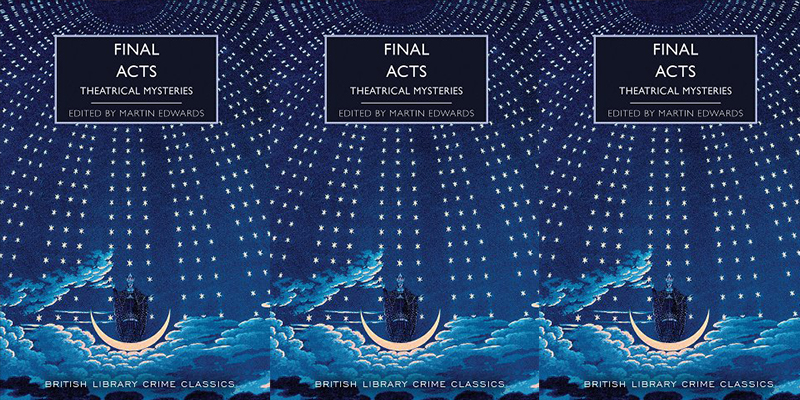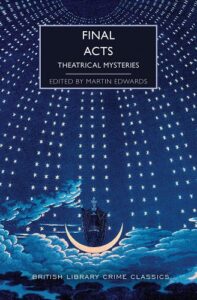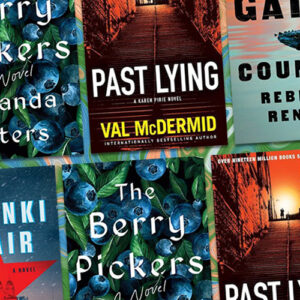Crime writers utilize an extraordinarily wide range of back-grounds for their stories, but the stage is one of the most popular of them all. Stories set in—or connected with—the theatre, concert halls, or similar venues have entertained readers since the nineteenth century, and there is no sign of this changing. One of the main strengths of Janice Hallett’s recent bestseller The Appeal, for instance, is that the story revolves around the members of a local amateur dramatic group who are involved with a production of Arthur Miller’s All My Sons.
It’s interesting to speculate why the stage exerts such an appeal for mystery writers. A minority of crime authors are themselves enthusiastic actors; this tradition goes back to the days of Wilkie Collins and Charles Dickens, who were keen amateur performers on the stage, and encompasses a wide range of twentieth-century crime novelists. They include Dulcie Gray (who played Miss Marple on the stage and whose own titles included Epitaph for a Dead Actor in 1960 and Understudy to Murder in 1972) and the less celebrated Fiona Sinclair, whose tragic early death in 1961 deprived crime fiction of an emerging talent. Alex Atkinson was an actor whose solitary venture into mystery fiction, Exit Charlie, was published in 1955 and remains a good read. V. C. Clinton-Baddeley was a playwright as well as an actor who turned to writing traditional detective novels late in life; his final mystery, To Study a Long Silence, posthumously published in 1972, takes its title from John Webster and makes good use of his knowledge of the performing arts.
Simon Brett, a former president of Oxford University Dramatic Society, proceeded to achieve sustained success as a playwright and as a prolific author, not least of the wonderfully entertaining Charles Paris series, which includes such witty titles as Cast, in Order of Disappearance (1975) and Not Dead, Only Resting (1984). The contemporary American popular singer and composer Rupert Holmes, whose CV includes a superb murder mystery musical about a musical, Curtains, makes effective use of his understanding of the world of showbiz in his novel Where the Truth Lies, which was filmed by Atom Egoyan in 2005.
Ngaio Marsh was an accomplished exponent of detective fiction in the Golden Age vein, but there is no doubt that the first love of Roderick Alleyn’s creator was the theatre, a field in which she achieved distinction. Her intimate knowledge of the theatre enabled her to use the world of the stage convincingly in several of Alleyn’s cases, including Opening Night and Vintage Murder, which is set in her native New Zealand.
Josephine Tey is the pen-name by which another “Queen of Crime,” Elizabeth MacKintosh, is today best remembered, not least in the form of a blue plaque installed in her home town of Inverness in 2022, but she first came to prominence as Gordon Daviot, whose 1932 play Richard of Bordeaux ran for over a year in the West End and made a star of John Gielgud. Her love of the theatre spills over into some of her detective fiction; in her debut mystery, The Man in the Queue, the queue in question is outside a theatre, while an actress is drowned in A Shilling for Candles, a story which benefits from her inside knowledge of the theatrical world.
The most commercially successful female playwright in history is none other than Agatha Christie. Murder mystery plays constitute a subject in themselves (explored in depth by Amnon Kabatchnik in a series of massive and highly informative tomes, Blood on the Stage) and Christie’s The Mousetrap is legendary for its longevity, while Witness for the Prosecution is a superb courtroom drama. Three-Act Tragedy is a Hercule Poirot novel that weaves the theatrical into the storyline with breathtaking ingenuity; to say much more would be a spoiler, but the book is an underestimated example of her mastery of her craft. There is also an important theatrical component in another of Poirot’s cases, Lord Edgware Dies.
Shakespearean references abound in the Christie canon and in crime fiction generally. Clifford Witting’s Measure for Murder, for instance, is set around an am dram version of Measure for Measure, while there are no prizes for guessing the title of the play which is the subject of a school production in Michael Gilbert’s excellent crime novel The Night of the Twelfth.
Many writers have taken advantage of the fact that the theatre and the concert hall offer marvellous opportunities for a dramatic murder; the same is, of course, true in film and television, as with Alfred Hitchcock’s two versions of The Man Who Knew Too Much. The opportunities are not only endless, but also infinitely varied. Take, for instance, two American crime novels which appeared close together in time (1929 and 1931) but which could hardly be more different in terms of content and style. Ellery Queen’s debut whodunit, The Roman Hat Mystery, is a cerebral puzzle concerning the death of a lawyer who is a member of a theatre audience. Raoul Whitfield’s Death in a Bowl concerns the killing of maestro Hans Reiner at the Hollywood Bowl, which gives rise to another case for Ben Jardinn, a tough Los Angeles detective. The novel is a minor classic of the hardboiled sub-genre and a world away from the good-natured gentility of Sebastian Farr’s Death on the Down Beat and Cyril Hare’s When the Wind Blows, both of which see murder committed at a concert.
Actors regularly pop up as characters in murder mysteries, no doubt because their chameleon skills are very useful in stories in which imposture and identity switches form a key ingredient. Occasionally they operate as amateur detectives; Charles Paris is one prominent example, while Anne Morice’s Tessa Crichton, although less well-known, enjoyed a lengthy career as a sleuth. In Ruth Rendell’s best-selling series about the Sussex cop Reg Wexford, a key presence in the supporting cast is his daughter Sheila, a successful actress who plays a significant part in several of the novels.
Short stories set in the world of the stage are not quite as plentiful, but in this anthology I have endeavoured to provide a mix of mysteries featuring famous crime writers and also those who are long-forgotten. I’m grateful to Nigel Moss, Jamie Sturgeon, and John Cooper for their suggestions and advice and also to everyone at the British Library who helped to bring this collection to life.
__________________________


















